Winter means only one thing for a lot of anglers: time to garage the boat and wait until the cold fronts pass and the snapper migration kicks into gear again. It won’t be long before this all happens, but for now we still have a month of winter left and plenty of hungry fish are still on offer.
Once such species is the humble King George whiting. The run of winter whiting has been largely on the increase over the past few years, so they’re definitely not just a summer target.
When it comes to locations, catching whiting throughout the cooler months is no different from catching them during the warmer months. The fish inhabit similar territory but do move about quite a bit, so finding a school of hungry fish can be quite time consuming.
Of the most popular locations, St Leonards on the Bellarine Peninsula and Blairgowrie on the Mornington Peninsula are the two most boasted about winter whiting haunts. In fact, even though these two locations get fished quite heavily they produce some remarkable fish.
Of course, it is not just these two locations that produce whiting throughout winter. Mornington, Mt Martha, Portsea and Sorrento are alive with these golden beauties too.
What all these locations have in common is the kind of habitat that can be found there: a mixture of weed beds and sand holes. From there the whiting seek out crustaceans to prey upon. Finding this type of ground is the key ingredient to finding whiting during both summer and winter.
Once you’ve found a likely location, your next challenge is to find the fish. During the summer months anglers tend to drop anchor, fish for 10 minutes and then (if they have no action) up anchor and move a few meters away before trying again. Some anglers might make 20 moves in a session until they find a school. Throughout winter, however, this approach isn’t ideal. The fish are actually harder to locate this way.
An alternative method, and one that’s highly successful, is using a concoction of berley. When you’re attempting to find a school of fish, using a single bait in a large area won’t bring the whole school to your immediate location, whereas a constant flow of fish offal can.
When it comes to berley there’s no need to go overboard. Sometimes the ‘KISS’ (Keep It Simple Stupid) approach is best. Some anglers can’t help but toss in unusual ingredients like dog food, cat food and who knows what else, but it’s not necessary; a 1kg bag of frozen pilchards is more than enough to get the party started. Simply place the pilchards into a berley pot, mash them up a little and lower the pot to the seafloor. The force of the current will disperse the fishy scent and your trap will bet set.
Targeting whiting throughout the winter period is a little different than during the summer months because the techniques vary according to how the fish react to the baits. Whiting are quite temperamental feeders at times. During one tide they can be aggressive while on the next tide they can be timid.
You should be able to pick up on their feeding habits after catching a few, and then you can switch tactics to further your success. If you’re finding they’re quite aggressive in taking your offerings, you might not have to worry about changing tactics at all. On the other hand, if you’re finding the fish to be a little tentative, a minor change might be in order to be able to set the hook.
When it comes to tactics, the standard paternoster rig with a Mustad no. 6 Demon circle hook suits most whiting fishing situations. However, when the fish are timid, switching to a running sinker rig with long shank hook is more beneficial. In this situation, I tie my rig with 8lb SureCatch fluorocarbon and a Mustad no. 6 92647S model hook. The reason I’m being so specific about the hook is because it’s an offset stainless steel mid shank hook. In situations where the fish are timid and the angler has to strike, the offset barb will penetrate due to the small gape, whereas a circle hook might not.
Fluorocarbon leader is great in the shallow water because it’s nearly invisible. The refraction properties of fluorocarbon (i.e. the way light bends as it passes through) are similar to water, which is why fluoro leaders blend in much better than standard nylon trace does. Fluorocarbon is also more abrasion resistant, which is a benefit when fishing in weed and over shallow reef.
When it comes to targeting winter whiting, one of the most talked about topics over the years has been which baits work best. Pilchard fillets, slivers of fresh fish flesh, calamari strips, mussel and so forth always seem to come up in conversation, but they’re not my first choice. Give me frozen pipis any day! They’ve produced well for me over the past decade.
Other baits which work well are mussel and of course tenderised calamari strips. Whiting can be fussy at times and you can’t go out armed just with one bait in case the fish prefer another on the day. For the cost of a bag of mussel or a quick drift over a shallow weed bed to catch a fresh calamari, you’ll maximise your chances of taking home a good feed.
Facts
WINTER WHITING GPS MARKS
1. St Leonards: S 38 11.741 E 144 44.172
2. Blairgowrie: S 38 20.941 E 144 47.377
3. Sorrento: S 38 19.420 E 144 44.847
4. Portsea: S 38 18.986 E 144 43.097
5. Mornington: S 38 12.926 E 145 01.893
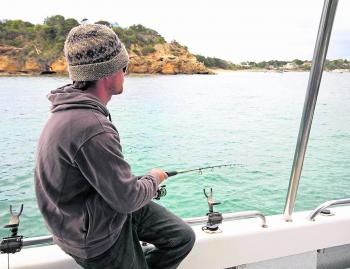
While winter whiting can be finicky feeders, holding the rod in your hand rather than leaving it in the rod holder will be the difference between catching whiting and not. Joe Farr from Joe Farr Fishing Charters knows th
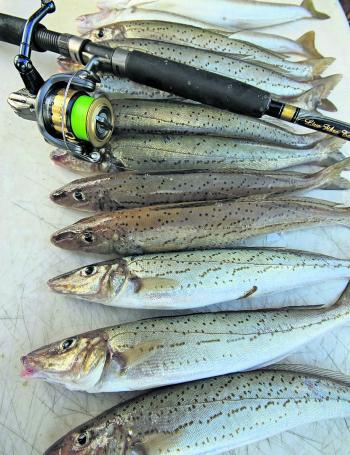
It might not be a summer bag’s worth of whiting, but in winter this is a cracking catch of quality fish.

Simple berley methods are often the best. A handful of pilchards in a pot at a time will do the job nicely.

Winter whiting can be quite plump. If you spend the time sifting through the littlies you’ll end up with a nice feed of fat fish.

First light is the key in catching quality whiting. It may be cold but there are fewer boats on the water.

When the word is out, the brave go winter whiting fishing.
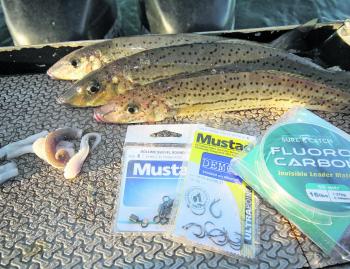
Successfully catching winter whiting requires a few key items. Fluorocarbon leader is a must, along with either a size 6 circle hook or offset mid-shank hook.
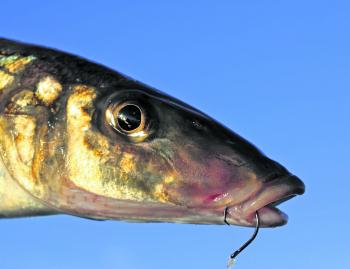
When the whiting are aggressively feeding, a circle hook is deadly. Here a Mustad Demon no. 6 pins the corner of the jaw.
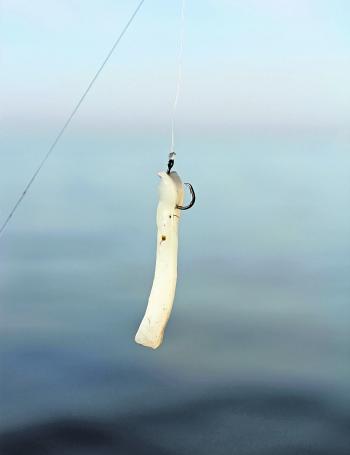
A Mustad Demon no. 6 loaded up with a strip of calamari about to be deployed to the bottom.
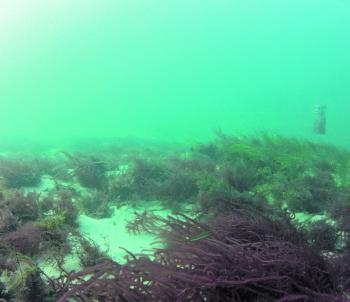
Whiting ground might be nothing special but when weed and sand is in the area, they won’t be too far away.




